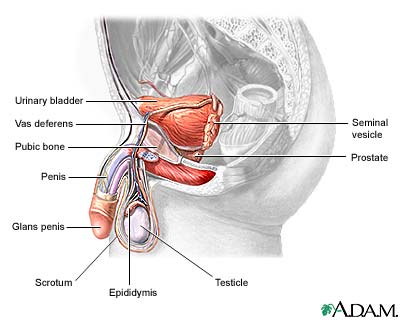Treatment
Treatment depends on the:
- Type of testicular tumor
- Stage of the tumor
Once cancer is found, the first step is to determine the type of cancer cell by examining it under a microscope. The cells can be seminoma, nonseminoma, or both.
The next step is to determine how far the cancer has spread to other parts of the body. This is called “staging.”
- Stage I cancer has not spread beyond the testicle.
- Stage II cancer has spread to lymph nodes in the abdomen.
- Stage III cancer has spread beyond the lymph nodes (it could be as far as the liver, lungs, or brain).
Three types of treatment can be used.
- Surgical treatment removes the testicle (orchiectomy) and nearby lymph nodes (lymphadenectomy). This is usually performed in the case of both seminoma and nonseminomas.
- Radiation therapy using high-dose x-rays or other high-energy rays may be used after surgery to prevent the tumor from returning. Radiation therapy is usually only used for treating seminomas.
- Chemotherapy uses drugs such as cisplatin, bleomycin, and etoposide to kill cancer cells. This treatment has greatly improved survival for patients with both seminomas and nonseminomas.
Support Groups
Joining a support group where members share common experiences and problems can often help the stress of illness. Your local branch of the American Cancer Society may have a support group. See: www.cancer.org for more information.
Lance Armstrong, a famous cyclist, is a survivor of testicular cancer. His web site — www.laf.org — offers support and information for patients with testicular cancer.
The National Cancer Institute website also provides further information: www.cancer.gov
Prognosis (Expectations)
Testicular cancer is one of the most treatable and curable cancers.
The survival rate for men with early-stage seminoma (the least aggressive type of testicular cancer) is greater than 95%. The disease-free survival rate for Stage II and III cancers is slightly lower, depending on the size of the tumor and when treatment is begun.
Complications
Testicular cancer may spread to other parts of the body. The most common sites include the:
- Abdomen
- Lungs
- Retroperitoneal area (the area near the kidneys)
- Spine
Complications of surgery can include:
- Bleeding and infection after surgery
- Infertility (if both testicles are removed)
If you are of childbearing age, ask your doctor about methods to save your sperm for use at a later date.
Calling Your Health Care Provider
Call your health care provider if you have symptoms of testicular cancer.
Pictures & Images
Male reproductive anatomy
-
Testicular cancer: Overview, Causes
-
Testicular cancer: Symptoms & Signs Diagnosis & Tests
-
Testicular cancer: Treatment
Review Date : 4/5/2009
Reviewed By : David C. Dugdale, III, MD, Professor of Medicine, Division of General Medicine, Department of Medicine, University of Washington School of Medicine; Yi-Bin Chen, MD, Leukemia/Bone Marrow Transplant Program, Massachusetts General Hospital. Also reviewed by David Zieve, MD, MHA, Medical Director, A.D.A.M., Inc.
